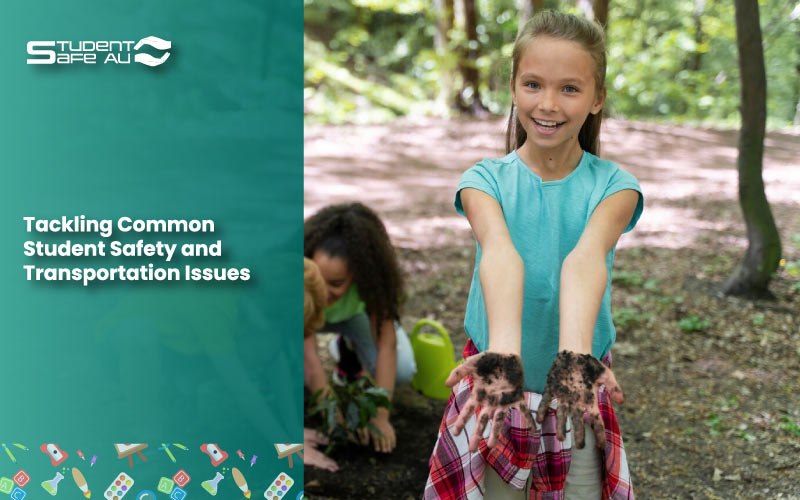Common school safety and transport issues.
Ensuring student safety and efficient transportation is a paramount concern for schools across Australia. Each year, school administrators grapple with a myriad of challenges that can impact students’ well-being and security. These issues, from logistical nightmares to safety breaches, need strategic planning and robust solutions.
Let’s examine common school safety issues and transportation hurdles, offering practical advice on how to address them effectively. In the end, we’ll discuss how partnering with StudentSafe AU can transform the cost, efficiency, and management of student safety and transport.
Common Student Safety Issues
- Bullying and Violence Bullying, whether physical, verbal, or cyber, remains a prevalent issue in schools. Addressing this requires a comprehensive anti-bullying policy, regular workshops, and a robust support system for victims.
- Emergency Preparedness Natural disasters, fires, and other emergencies can pose significant threats. Schools must have well-documented emergency procedures, conduct regular drills, and ensure that all staff and students are well-versed in these protocols.
- Medical Emergencies Medical issues can arise unexpectedly. Schools should have trained first-aiders, accessible medical supplies, and clear procedures for handling medical emergencies.
- Supervision During Activities Ensuring adequate supervision during school activities and trips is crucial. A lack of supervision can lead to accidents or misconduct. Schools need to maintain appropriate student-to-teacher ratios and have clear supervision policies.
- Cybersecurity Threats With the increasing use of technology, schools must safeguard students from cyber threats. Implementing robust cybersecurity measures and educating students about safe online practices are essential.
Transportation Issues
- Route Planning and Scheduling Poorly planned routes and schedules can lead to delays and confusion. Schools must optimise routes and ensure timely pickups and drop-offs to avoid disruptions.
- Vehicle Maintenance and Safety The safety of school transport depends heavily on the condition of the vehicles. Regular maintenance checks and compliance with safety standards are non-negotiable.
- Driver Training and Conduct: Ensuring that drivers are well-trained and adhere to safe driving practices is critical. Schools should invest in regular training programs and background checks for drivers.
- Student Behaviour on Buses Managing student behaviour during transit can be challenging. Clear rules and monitoring and promptly addressing any issues can help maintain discipline.
- Communication Gaps Effective communication between the school, parents, and student transport providers is vital. Lack of communication can lead to confusion and safety concerns. Schools should establish clear communication channels and keep all stakeholders informed.
Preventative Measures for Schools
- Develop Comprehensive Policies Schools should develop and enforce comprehensive policies addressing bullying, emergency procedures, medical emergencies, and transportation protocols. These policies should be regularly reviewed and updated.
- Regular Training and Drills Conduct regular training sessions for staff and students on safety protocols, emergency procedures, and cybersecurity. Drills should be held periodically to ensure preparedness.
- Invest in Technology Implement technology solutions such as GPS tracking for buses, CCTV cameras, and secure communication platforms. These tools can enhance safety and streamline operations.
- Engage Parents and Community Keeping parents informed and involved can enhance safety measures. Regular communication and community involvement in safety initiatives can create a supportive environment.
- Continuous Evaluation and Improvement Regularly evaluate safety and transportation protocols to identify areas for improvement. Feedback from staff, students, and parents can provide valuable insights.

Why StudentSafe AU is the Right Partner
For independent schools in Australia looking to improve student safety and transport, partnering with StudentSafe AU is a game-changer. Here’s why:
- Expertise and Experience: StudentSafe AU brings extensive experience and expertise in managing school safety and transportation. Our comprehensive solutions are tailored to meet schools’ unique needs.
- Cost-Efficiency Managing safety and transport internally can be costly and resource-intensive. StudentSafe AU offers cost-effective solutions that optimise resources without compromising quality or safety.
- Advanced Technology StudentSafe AU leverages advanced technology to enhance safety and efficiency. They ensure seamless and secure systems, from GPS tracking to secure communication platforms.
- Professional Training and Support StudentSafe AU provides regular training for school staff and drivers, ensuring they are well-equipped to handle any situation. Continuous support and consultation services help schools stay ahead of potential issues.
- Customised Solutions: Recognising that every school is unique, StudentSafe AU offers customised solutions tailored to each school’s specific needs and challenges. This personalised approach ensures maximum effectiveness and satisfaction.
Conclusion
Addressing school safety issues and school transportation challenges requires proactive planning and reliable partnerships. By implementing the preventive measures outlined above and partnering with StudentSafe AU, schools can significantly enhance the safety and efficiency of their operations. This ensures a secure environment for students and provides peace of mind for parents and educators alike.
So, make the smart choice and let StudentSafe AU be your reliable bus hire for education and trusted partner in creating a safer, more efficient school environment.
